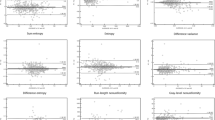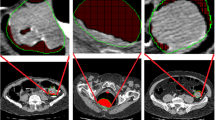Abstract
Purpose
Differentiation of colon lesions according to underlying pathology, e.g., neoplastic and non-neoplastic lesions, is of fundamental importance for patient management. Image intensity-based textural features have been recognized as useful biomarker for the differentiation task. In this paper, we introduce texture features from higher-order images, i.e., gradient and curvature images, beyond the intensity image, for that task.
Methods
Based on the Haralick texture analysis method, we introduce a virtual pathological model to explore the utility of texture features from high-order differentiations, i.e., gradient and curvature, of the image intensity distribution. The texture features were validated on a database consisting of 148 colon lesions, of which 35 are non-neoplastic lesions, using the support vector machine classifier and the merit of area under the curve (AUC) of the receiver operating characteristics.
Results
The AUC of classification was improved from 0.74 (using the image intensity alone) to 0.85 (by also considering the gradient and curvature images) in differentiating the neoplastic lesions from non-neoplastic ones, e.g., hyperplastic polyps from tubular adenomas, tubulovillous adenomas and adenocarcinomas.
Conclusions
The experimental results demonstrated that texture features from higher-order images can significantly improve the classification accuracy in pathological differentiation of colorectal lesions. The gain in differentiation capability shall increase the potential of computed tomography colonography for colorectal cancer screening by not only detecting polyps but also classifying them for optimal polyp management for the best outcome in personalized medicine.










Similar content being viewed by others
References
American Cancer Society (2012) Cancer facts & figures 2012. American Cancer Society, Atlanta, GA
Eddy D (1990) Screening for colorectal cancer. Ann Intern Med 113:373–384
Gluecker T, Johnson C, Harmsen W, Offord K, Harris A, Wilson L, Ahlquist D (2003) Colorectal cancer screening with CT colonography, colonoscopy, and double-contrast barium enema examination: prospective assessment of patient perceptions and preferences. Radiology 227(2):378–384
Summers R, Beaulieu C, Pusanik L, Malley J, Jeffrey R, Glazer D, Napel S (2000) Automated polyp detector for CT colonography: feasibility study. Radiology 216(1):284–290
Yoshida H, Nappi J (2001) Three-dimensional computer-aided diagnosis scheme for detection of colonic polyps. IEEE Trans Med Imaging 20(12):1261–1274
Wang Z, Liang Z, Li L, Li X, Li B, Anderson J, Harrington D (2005) Reduction of false positives by internal features for polyp detection in CT-based virtual colonoscopy. Med Phys 32(12):3602–3616
Zhu H, Fan Y, Lu H, Liang Z (2010) Improving initial polyp candidate extraction for CT colonography. Phys Med Biol 55:2087–2102
Zhu H, Fan Y, Lu H, Liang Z (2011) Improved curvature estimation for computer-aided detection of colonic polyps in CT colonography. Acad Radiol 18(8):1024–1034
Pickhardt P, Kim D (2009) Colorectal cancer screening with CT colonography: key concepts regarding polyp prevalence, size, histology, morphology, and natural history. AJR Am J Roentgenol 193(1):40–46. doi:10.2214/AJR.08.1709
Kumar V, Abbas A, Fausto N, Aster J, Perkins J (2010) Polyps. In: Robbins SL, Cotran RS (eds) Pathologic basis of disease, 8th edn. Saunders/Elsevier, Philadelphia, PA. ISBN 978-1-4160-3121-5
Winawer S, Zauber A (2002) The advanced adenoma as the primary target of screening. Gastrointest Endosc Clin N Am 12:1–9
Mills S, Carter D, Greenson J, Reuter V, Stoler M et al. (2010) Sternberg’s diagnostic surgical pathology, 5th edn. Lippincott Williams & Wilkins
Castellano G, Bonilha L, Li L, Cendes F (2004) Texture analysis of medical images. Clin Radiol 59(12):1061–1069
Haralick R, Shanmugam K, Dinstein I (1973) Textural features for image classification. IEEE Trans Syst Man Cybern 3(6):610–621
Ji Q, Engel J, Craine E (2000) Texture analysis for classification of cervix lesions. IEEE Trans Med Imaging 19(11):1144–1149
Philips C, Li D, Raicu D, Furst J (2008) Directional invariance of co-occurrence matrices within the liver. In: International conference on biocomputation, bioinformatics, and biomedical technologies
Fiori M, Musé P, Aguirre S, Sapiro G (2010) Automatic colon polyp flagging via gometric and texture features. Conf Proc IEEE Eng Med Biol Soc 1:3170–3173. doi:10.1109/IEMBS.2010.5627185
Yao J, Dwyer A, Mollura D (2011) Computer-aided diagnosis of pulmonary infections using texture analysis and support vector machine classification. Acad Radiol 18(3):306–314
Rahmim A, Couhglin J, Gonzalez M, Endres C, Zhou Y, Wong D, Wahl R, Sossi V, Pomper M (2012) Novel parametric PET image quantification using texture and shape analysis. In: Proceedings of the IEEE nuclear science symposium and medical imaging conference
Ng F, Ganeshan B, Kozarski R, Miles K, Goh V (2013) Assessment of primary colorectal cancer heterogeneity by using whole-tumor texture analysis: contrast-enhanced CT texture as a biomarker of 5-year survival. Radiology 266(1):177–184
Suzuki K et al. (2012) Computer-aided Diagnosis (CADx) for distinguishing neoplastic from non-neoplastic lesions toward CT colonography (CTC) beyond detection. In: Program of scientific assembly and annual meeting of radiological society of North America (RSNA), LL-GIS-TU5C, November 2012
Zhang G, Song B, Zhu H, Liang Z (2012) Computer-aided diagnosis in CT colonography based on bi-labeled classifier. In: The 26th international congress and exhibition on computer assisted radiology and surgery (CARS). International Journal of CARS, vol 7(Suppl), p S274
Engel K (2006) Real-time volume graphics. A K Peters, Wellesley, MA
Monga O, Benayoun S (1995) Using partial derivatives of 3D images to extract typical surface features. Comput Vis Image Underst 61(2):171–189
van Wijk C, van Ravesteijn V, Vos F, van Vliet L (2010) Detection and segmentation of colonic polyps on implicit isosurfaces by second principal curvature flow. IEEE Trans Med Imaging 29(3):688–698
Deriche R (1987) Using Canny’s criteria to derive a recursively implemented optimal edge detector. Int J Comput Vis 1(2):167–187
Haralick R, Shapiro L (1993) Computer and robot vision. Addison-Wesley Publishing Company, Reading, MA 1:453–508
Tesar L, Smutek D (2004) Bayesian classification of sonograms of thyroid gland based on Gaussian mixtures. In: Proceedings of Norvegian conference on image processing and pattern recognition, NOBIM, pp 36–40
Tesar L, Smutek D, Shimizu A, Kobatake H (2007) 3D extension of Haralick texture features for medical image analysis. In: SPPR 2007 proceedings of the fourth conference on IASTED international conference, pp 350–355
Tesar L, Shimizu A, Smutek D, Kobatake H, Nawano S (2008) Medical image analysis of 3D CT images based on extension of Haralick texture features. Comput Med Imaging Graph 32(6):513–520
Liang Z, Cohen H, Posniak E, Fiore E, Wang Z, Li B, Anderson J, Harrington D (2008) Texture-based CAD improves diagnosis for low-dose CT colonography. In: Proceedings of the SPIE medical imaging CD-ROM
Showalter C, Clymer B, Richmond B, Powell K (2006) Three-dimensional texture analysis of cancellous bone cores evaluated at clinical CT resolutions. Osteoporos Int 17:259–266
Pickhardt P, Kim D, Pooler B, Hinshaw J, Barlow D, Jensen D, Reichelderfer M, Cash B (2013) Assessment of volumetric growth rates of small colorectal polyps with CT colonography: a longitudinal study of natural history. Lancet Oncol 14(8):711–720
Li L, Chen D, Lakare S, Kreeger K, Bitter I, Kaufman A, Wax M, Djuric P, Liang Z (2002) An image segmentation approach to extract colon lumen through colonic material tagging and hidden Markov random field model for virtual colonography. In: Proceedings of the SPIE medical imaging vol 4683, pp 406–411
Wang S, Li L, Cohen H, Mankes S, Chen J, Liang Z (2008) An EM approach to MAP solution of segmenting tissue mixture percentages with application to CT-based virtual colonoscopy. Med Phys 35(12):5787–5798
Pickhardt P, Choi J, Hwang I, Butler J, Puckett M, Hildebrandt H, Wong R, Nugent P, Mysliwiec P, Schindler W (2003) Computed tomographic virtual colonoscopy to screen for colorectal neoplasia in asymptomatic adults. N Engl J Med 349:2191–2200
American College of Radiology (2005) ACR practice guideline for the performance of computed tomography (CT) colonography in adults. ACR Pract Guidel 29:295–298
Chang C, Lin C (2011) LIBSVM: a library for support vector machines. ACM Trans Intell Syst Technol 2(27):1–27
Song B, Zhang G, Zhu W, Liang Z (2014) ROC operating point selection for classification of imbalanced data with application to computer-aided polyp detection in CT colonography. Int J Comput Assist Radiol Surg 9(1):79–89
Fidler J, Johnson C, MacCarty R, Welch T, Hara A, Harmsen W (2002) Detection of flat lesions in the colon with CT colonography. Abdom Imaging 27:292–300
Pickhardt P, Choi J, Hwang I, Schindler W (2004) Nonadenomatous polyps at CT colonography: prevalence, size distribution, and detection rates. Radiology 232:784–790
Pickhardt P, Kim D, Robbins J (2010) Flat (nonpolypoid) colorectal lesions identified at CT colonography in a US screening population. Acad Radiol 17:784–90
Shah J, Hynan L, Rockey D (2009) Management of small polyps detected by screening CT colonography: patient and physician preferences. Am J Med 122(7):687.e1-9
Summers R (2010) Polyp size measurement at CT Colonography: what do we know and what do we need to know? Radiology 255(3):707–720
Fawcett T (2006) An introduction to ROC analysis. Pattern Recognit Lett 27:861–874
Suzuki K. et al. (2012) Observer performance study: effect of computer-aided diagnosis (CADx) on the performance of radiologists in distinguishing neoplastic from non-neoplastic lesions in CT colonography (CTC). In: Program of scientific assembly and annual meeting of radiological society of North America (RANA), SSA 07–08, November, 2012
Acknowledgments
This work was partially supported by the NIH/NCI under Grant #CA082402 and #CA143111. H. Lu is partially supported by the National Natural Science Foundation of China under Grant #81230035 and #81071220 and also the National Key Technologies R&D Program of China under Grant #2011BAI12B03. P. Pickhardt was partially supported by the NIH/NCI under Grant #CA144835, #CA169331 and #CA155347. The authors would like to acknowledge the use of the Viatronix V3D-Colon Module.
Conflict of interest
Bowen Song, Guopeng Zhang, Hongbing Lu, Huafeng Wang, Wei Zhu, Perry J. Pickhardt and Zhengrong Liang declare that they have no conflict of interest. Dr. Liang is a co-founder of Viatronix. Dr. Pickhardt has served as a consultant for Viatronix, Braintree and Mindways and is co-founder of VirtuoCTC.
Author information
Authors and Affiliations
Corresponding author
Rights and permissions
About this article
Cite this article
Song, B., Zhang, G., Lu, H. et al. Volumetric texture features from higher-order images for diagnosis of colon lesions via CT colonography. Int J CARS 9, 1021–1031 (2014). https://doi.org/10.1007/s11548-014-0991-2
Received:
Accepted:
Published:
Issue Date:
DOI: https://doi.org/10.1007/s11548-014-0991-2




